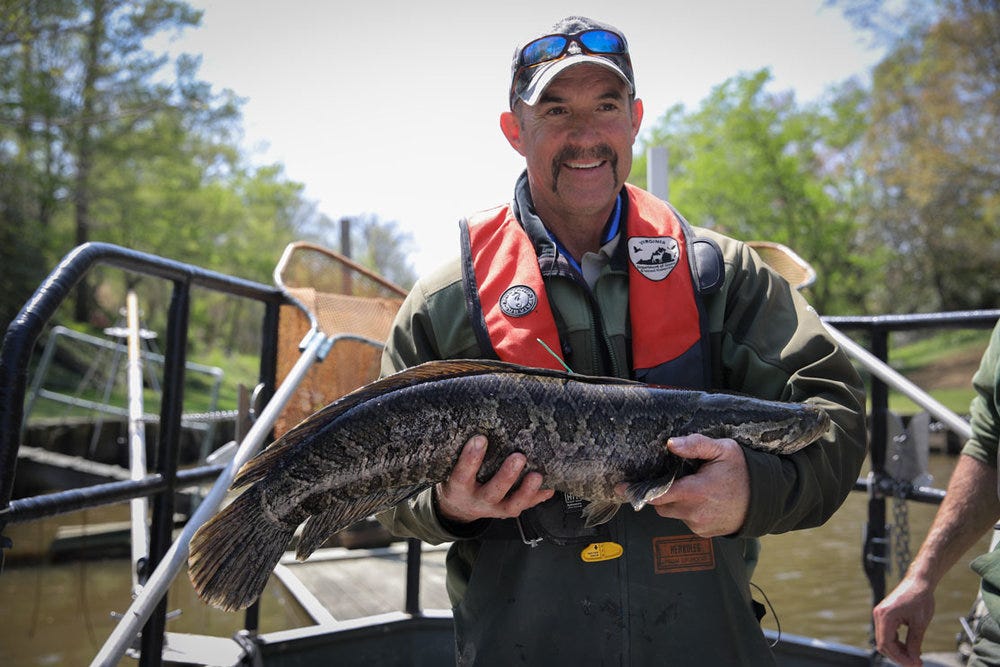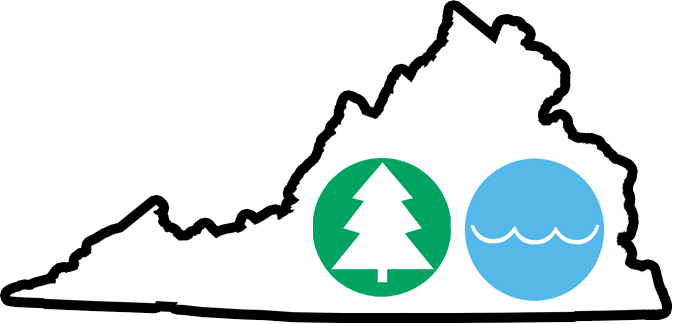Snakehead or so-called “Frankenfish” have been a resident of areas waters ever since 2002 when they first showed up in a Crofton, Maryland. These exotic fish from Asia have a nasty set of teeth, can breathe air and move out of water. They were accidentally introduced to the tidal Potomac when the pond dam on that pond in Crofton failed and snakeheads illegally stocked there were dumped into the Potomac River.
Snakeheads love marsh, lily pads and shallow water. This makes them thrive in the tidal Potomac and other similar rivers.
Anglers were worried at first snakeheads would impact bass fisheries negatively. They haven’t and in fact, the new residents have become a favorite species to pursue for many anglers wielding rod and bow.
The northern snakehead has a lifecycle that includes reaching sexual maturity (two to three years old), spawning multiple times per year, building nests to protect eggs and young, and exhibiting rapid growth and aggressive feeding habits.
Snakeheads typically spawn from spring to late summer, with peak spawning activity in the summer. Females can release anywhere from 1,300 to 15,000 eggs per spawn, and potentially up to 50,000 eggs per year.
Both parents participate in building a floating nest from aquatic vegetation in shallow, stagnant water. They aggressively guard the eggs and young for several weeks after hatching.
Newly hatched larvae feed on zooplankton, then transition to small insects and crustaceans, and eventually prey on small fish as juveniles. Adults are voracious predators, consuming a wide range of prey including fish, crustaceans, amphibians, reptiles, and even some birds and mammals.
Snakeheads typically live for about 8-10 years, though they can live up to 15 years in some cases. They are air-breathers, which allows them to survive in low-oxygen environments and even survive out of water for several days if kept moist.
While snakehead range continues to expand, the population in other longer-established fisheries has stabilized, even dropped in some cases. The end result is plenty of places to fish for these hard-fishing and tasty fish around the region. Here are our top five picks for you to try this summer.
Tidal Potomac River
Capt. Mike Sielicki and Chris Evans of Apex Predators Potomac Creek Guide Service love putting clients on tidal water snakeheads. Capt. Mike has been fishing the tidal Potomac for the past 44 years and began guiding in 2000. He mostly fishes the Aquia Creek, a tributary of the tidal Potomac River a lot and knows just how many snakeheads pack into this weed-infested shallow estuary.
“I caught my first snakehead bass fishing in Aquia and that’s when I knew that it was the next bass or game fish,” Capt. Mike told W2.
His choice or lures for snakehead include the Strike King vibrating jig, floating frogs and soft plastic creature baits.
One bait in particular, Sielicki feels is his most reliable.
“I feel that the Blitz Frogs are the best, mostly due to the material the frogs are made of and that the hook is very strong with a gap wider than that of most frogs. I’ve caught 8-10 snakeheads on one frog,” Mike said.
He also says he stumbled on the special frog while shopping at Ollie’s one day. After using them for a few trips, he contacted the owner of the bait company and suggested he market them for snakehead fishing.
We asked Capt. Mike if he had noticed any change in the tidal Potomac River snakehead fishing over the past 10 years.
“The change is that the larger fish over 32 inches are getting harder to find due to the fish getting smarter. I think the boat wake in shallow water alerts them now. I see many just swim away. I also believe that they can now sense the nighttime bow hunters. With over 10 years of them hunting, bowhunters are helping to control snakehead populations, on the other hand they are also disturbing the nighttime wildlife.”
Even with all this, Capt. Mike says he’s still able to catch over 600 snakehead per year.
For summer fishing on the tidal Potomac, Mike uses a 3/8- or ¼-oz. vibrating jig, Game Changer Eeliminator, Blitz Frogs, soft plastic creature baits like a Phat Pak.
Lake Anna
Memorial Day weekend is a busy time on Lake Anna and back in 2017 it was no different. On Sunday, May 28 a guest of a homeowner was fishing off a private dock using a live bluegill as bait. What happened next made Lake Anna history, as a northern snakehead fish engulfed the offering, and the surprised angler reeled it up and netted it.
Colby Horne landed the healthy 27-inch exotic fish and watched as it slithered like a snake on the dock.
Horne’s father, Garnie guessed the fish might be a snakehead and told his son they were supposed to be good to eat. The son thought the fish was too ugly to eat so after a few photos he turned it back into Gold Mine Creek.
Examination of the photos proved it was a northern snakehead, the first documented caught from the lake on the board of Spotsylvania, Louisa and Orange counties.
Virginia Department of Game & Inland Fisheries District Biologist John Odenkirk noted as far as he knew this was the first verifiable catch of a snakehead from Anna.
Several days later, Odenkirk conducted electroshocking sampling in other areas where snakeheads had been reported sighted.
“We sampled upper Freshwater Creek and upper Contrary Creek on our first run. We collected two sub-adult northern snakehead in upper Freshwater Creek. We saw no others in this location or in good habitat in Contrary Creek. We then sampled the area in upper Goldmine Creek where the adult was caught. We saw none there,” Odenkirk communicated in an email.
In the ensuing years, Anna has developed a solid snakehead fishery, especially in the mid and upper ends of the lake where water willow grows along many shorelines, offering snakeheads the habitat they prefer. Creeks with hydrilla also attract snakeheads on Anna.
The lake record was caught by a visiting angler in early May of this year and weighed 16-12.
Guide C.C. McCotter notes he and his clients catch snakeheads from time-to-time bass fishing – always around willow grass or hydrilla.
“They bite topwaters, spinnerbaits and soft plastic jerkbaits here,” he told W2. “They are a beautifully marked fish in our clear water with very distinctive black and brown markings that resemble a python.”
McCotter notes Lake Anna snakehead tend to take up a residence or territory and will stay there all summer until caught or arrowed. Peak times are May through September to catch them at the lake.
Blackwater National
Wildlife Refuge
Blackwater National Wildlife Refuge in Maryland is known as a prime location for snakehead fishing. These Maryland snakeheads thrive in the refuge’s shallow, weedy, and brackish waters. Anglers can find success using various techniques, including topwater lures, swimbaits and live killie minnows, especially when targeting snakeheads near lily pads, weed beds and fry balls during the summertime.
Blackwater was once a quiet and hidden gem of great fishing on Maryland’s Eastern Shore. The locations of snakehead were highly guarded and information was hard to come by.
In late 2019, that changed when a study was published that brought light to the surge of the northern snakehead in the brackish sanctuary near Cambridge. Locals took that information with the loss of local populations of largemouth bass, white perch, yellow perch and crappie and began inviting anglers to visit in hopes of controlling snakehead populations.
The way the refuge works is a little different; You technically can only fish from a few locations from shore as it’s prohibited for 99% of the refuge. This is because the shoreline is marsh and unsafe for walking. It is also to help preserve the natural shoreline. This means the best way to fish the refuge is from a proper boat or kayak. There are several kayak launching locations and one distant boat ramp to get into the refuge.
Tidal Rappahannock River
There are plenty of northern snakeheads in the tidal Rappahannock River. You will need to find submerged aquatic grass to find them, though. Some of the best areas are accessible from Port Royal Landing. Head just down river and you’ll find plenty of grass in a shallow bay about a half mile below the ramp, river right. Head further down river to Ritchie Point and explore the hydrilla-filled creeks and pockets there for Rapp snakeheads. Soft plastic stickbaits and spinnerbaits are good here.
We also Odenkirk what he thought were some top snakehead fisheries and as always, his response was insightful.
“This is not a straightforward a question as it would be for fish populations native or long-time naturalized, as snakehead populations appear to have a somewhat predictable trajectory based on initial increases in abundance post colonization followed by a decline in abundance once the population assimilates into the novel ecosystem and is also exploited (as anglers recognize and begin to target),” Odenkirk told W2. “There appears to be a peak in abundance about 10 to 12 years post colonization. Thus, populations that have been established for longer periods of time are likely off peak and may never reestablish population levels experienced in prior years. I guess this is a long way to say that snakehead populations change more than other species, so the ‘best’ fisheries designation is a moving target.”
All that being said, Odenkirk did note that within his work area (northern Virginia) “the best snakehead fisheries tend to be Potomac Creek (good habitat and no public access), Lake Anna (limited SAV and excellent size structure suggesting limited exploitation), tidal Rappahannock tributaries around Port Royal, and probably Aquia Creek (although it gets hammered by archery boats, it’s big enough and productive enough to still hold the most fish of our four long-term study creeks). “
The career biologist noted choke points and barriers can be really hot in spring when some fish move upstream in an apparent range expansion effort and/or to seek mates. One example he noted was the Occoquan fall-line, but also added that “spots like this have a short-term window in mid-April to mid-May.”



